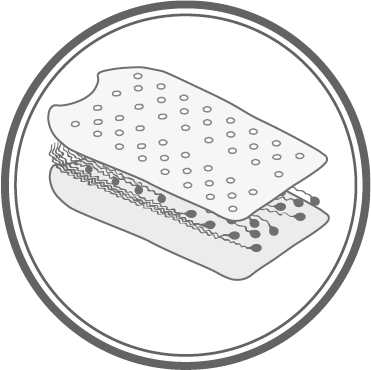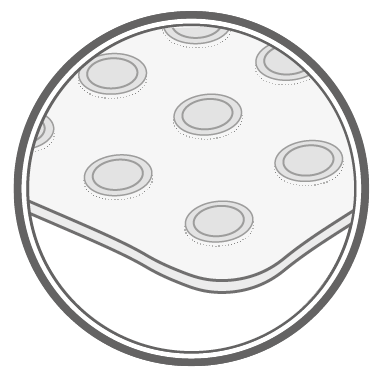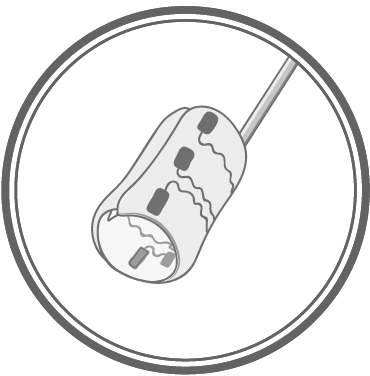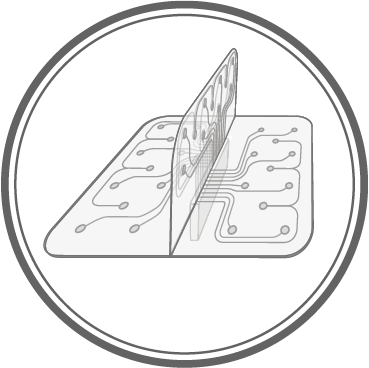Electrode Technology
Key Winning Features
- High Precision
Ultra-short pulse laser micromachining allows for very small feature sizes of down to 25 µm at highest reproducibility.
- Easy Adjustment of Mechanical Properties
Varying the thickness of silicone, parylene-C, or metal layers creates softer or harder electrode structures.
- Easy Adaptation of Shape and Functionality
Electrodes can be modified to build 3-dimensional assemblies as well as nerve cuff electrodes to be wrapped around peripheral nerves.Further adaptions include the integration of microfluidic channels for drug delivery into electrode arrays.
- Excellent Electrochemical Properties
Platinum-Iridium or MP35N are used as standard electrode materials.Other materials are available upon request. To improve charge injection capacity, high performance coatings can be provided.
- High Level of Patient Safety
Mechanical interlocking mechanisms prevent electrode contacts from dislocation and ensure safe contact to neural tissue.
- Improved Usability and Reliability
Great mechanical adaptability make surgical handling significantly easier. Superior reliability maintains full electrode functionality even under recurring loads.
- Freedom of Design
Freedom of Design of the shape of electrode contacts and outlines allows for significantly higher performance of planar or cuff electrodes during stimulation and recording.
Design Options

Multi-Layer Functionalization
- Adjustment of thickness and flexibility by number and type of polymer or metal layers
- Adaptation of contact density and functionality by number and type of metal layers
- Integration of microfluidic channels and ports

General Dimensions
Thickness
- Silicone electrodes: 0.15 mm – 1 mm
- Hybrid silicone-parylene electrodes: 0.08 mm – 1 mm
Contact size
- Silicone electrodes: down to 0.1 mm
- Hybrid silicone-parylene electrodes: down to 0.05 mm
Contact spacing
- Silicone electrodes: down to 0.3 mm center-to-center
- Hybrid silicone-parylene electrodes: down to 0.08 mm center-to-center
- Depending on number of contacts
Contact shape: round, rectangular or arbitrary
Design geometry maximum: 90 mm x 90 mm
Various designs for electrode outline incl. slit contours

Design Variations – Cuff Electrodes
Inner diameter: starting from 0.1 mm
Number of contacts: arbitrary
Closing mechanisms:
- Split cylinder
- Buckle-and-belt
- Self-spiraling
- Piano hinge
Further closing mechanisms for chronic implantation can be developed

Other Variations
Folding planar AirRay™ electrodes
3D assembly of multiple AirRay™ electrodes
Intrafascicular electrodes
Combination with other technologies:
- Depth electrodes
- 3D metal parts
Functional components such as surgical mesh or suture material
More technical Information
Materials
Polymers | ||
Medical grade silicone rubber: Long–term (≥ 30 days) Short–term (< 30 days) | Parylene–C | |
Metals | ||
Medical grade metal alloys: Platinum-Iridium (90/10) Platinum MP35N Stainless Steel Gold | High–performance coatings: Sputtered Iridium Oxide (SIROF) Platinum Black | Physical surface modification permits additional adaptations to the individual application. |
Performance
Charge Injection | Impedance | Impedance | |
MP35N | Max. 0,03 | 260 kΩ 5 kΩ | 32 kΩ 0,6 kΩ |
Platinum-Iridium (90/10) | 0,09 mC/cm2 | 47 kΩ 1 kΩ | 8 kΩ 0,2 kΩ |
Platinum | 0,05 mC/cm2 | ||
Sputtered Iridium Oxide (SIROF) | 1 mC/cm2 | ||
Platinum Black | 0,25 mC/cm2 |
Related Services
- Device design
- Tests/validations of new designs incl. technical documentation
- Impedance spectroscopy
Characterization of the electrode’s recording performance.
- Pulse testing
Characterization of the electrode’s stimulation performance.
- Sterilization
We offer ethylene oxide sterilization including peel-pouch or blister packaging in collaboration with external partners. Upon request steam sterilization using sterile pouches is offered as in-house service.
- Corrosion testing
Evaluating the corrosion resistance of a particular electrode design for a given stimulation paradigm.
- Reliability testing
Common cyclic bending and pull tests under different environmental conditions but also setups tailored to the customer’s needs.
